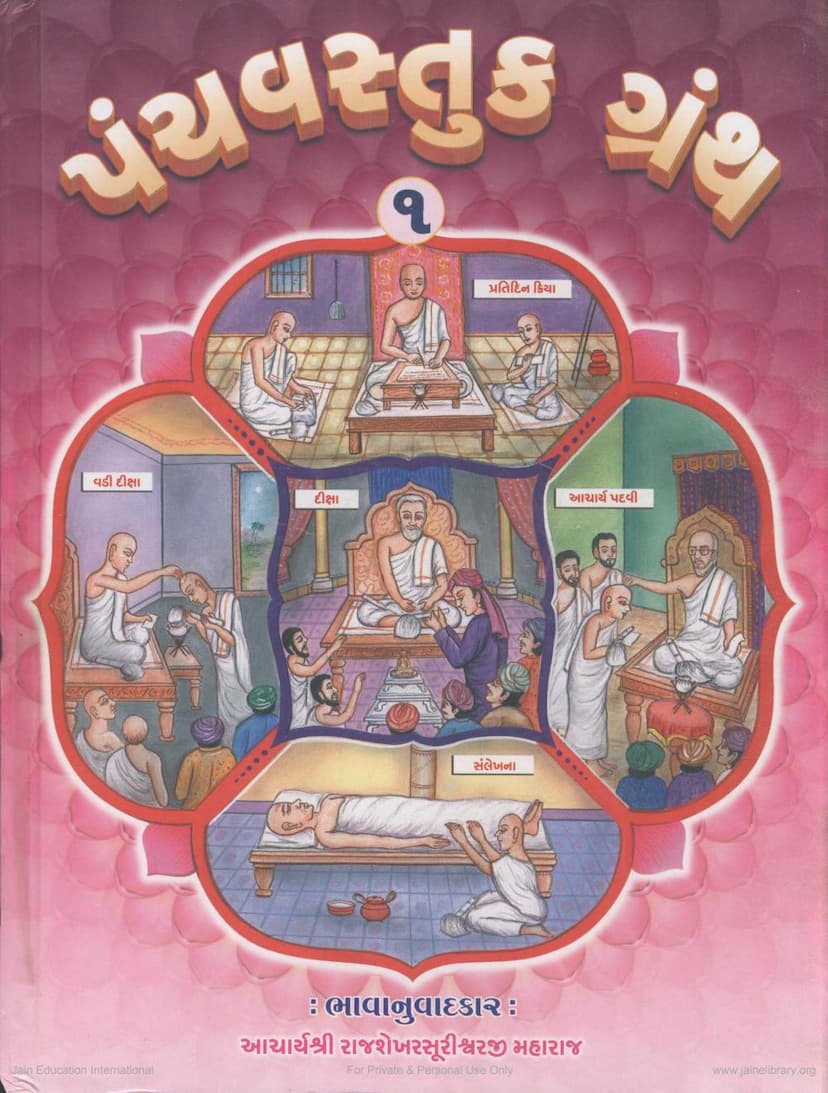Panchvastukgranth Part 1
Added to library: September 2, 2025

Summary
The "Panchvastukgranth Part 1" is a significant Jain text authored by Acharya Shri Haribhadrasurishwarji Maharaj and translated and commented upon by Acharya Shri Rajashekhar Surishwarji Maharaj. Published by Arihant Aradhak Trust, this book is the first volume of a comprehensive work that delves into the profound aspects of the Jain monastic path.
Core Theme: The "Panchvastukgranth" meticulously outlines the journey of a Jain monk (Shraman) from birth (initiation) until their final departure from the mortal coil (Kal-dharma or Samlekhana). It focuses on five essential "vastus" or topics that govern a monk's life and spiritual practice, aligning with the teachings of Lord Mahavir.
Key Contents and Structure: The book is structured around five core "vastus," which can be generally understood as:
-
Pravrajya Vidhan Vastu (On Initiation): This section details the process of initiation into monastic life. It covers crucial aspects such as the qualifications and motivations required for initiation, the qualities of a guru who bestows initiation, the necessary virtues in a disciple, the philosophical and logical justifications for infant (Bal) initiation, and the methods for seeking parental consent. It addresses contemporary debates and refutes flawed arguments against initiating children, highlighting the foresight of its author.
-
Pratidin Kriya Vastu (On Daily Practices): This extensive section details the minute-by-minute routine and observances of a monk. It covers daily rituals like 'Pratilekhana' (purification of one's belongings and surroundings), 'Bhiksha Vidhi' (the discipline of alms-seeking and eating), the importance of introspection and contemplation, the principles of scriptural study and its timing, and the practice of 'Kausargga' (austerity of posture) and 'Pachchakkhan' (vows and resolutions). It emphasizes the detailed care taken by scripture-writers to ensure the spiritual purity of the monastic life.
-
Upasthapana Vastu (On Ordination and Establishment in Vows): This part focuses on the formal establishment of an initiated monk into the higher vows ('Vratas'). It discusses the qualifications for this "Vadi Diksha" (senior initiation), the importance of 'Gurukulvas' (living under the guidance of a guru), the merits and demerits of monastic residences ('Vasati'), and the proper conduct related to alms-seeking, avoiding specific types of tainted food ('Adhakarma'), and the number and nature of possessions ('Upadhi'). It also touches upon internal and external austerity ('Bahya-Abhyantar Tap').
-
Anuyoga Gana Anugnya Vastu (On Appointment to Authority and Guidance): This section deals with the appointment of a qualified disciple to positions of spiritual authority, such as the 'Acharya Padvi' (title of Acharya). It elaborates on the faults arising from appointing an unworthy person or failing to appoint a deserving one. It discusses the significance of establishing a new Acharya in the 'Gachchha' (monastic order) and the process of conferring this authority, including the concept of 'Geetartha' (one who has deeply understood the scriptures). It also touches upon the correct procedure for establishing Jain idols and temples ('Stavparigya') and the ethical guidelines for newly appointed Acharyas and the order.
-
Samlekhana Vastu (On Voluntary Fasting Unto Death): This final section discusses 'Samlekhana,' the Jain practice of voluntary fasting unto death as a means of spiritual purification, particularly undertaken at the end of one's life. It clarifies that 'Samlekhana' is a rigorous ascetic practice that weakens the body and passions. It distinguishes Samlekhana from suicide, explains its fruits and benefits, and outlines the prerequisites for undertaking it, the necessary qualifications, and the precautions to be taken by those who accept it.
Significance of the Translation and Commentary: Acharya Rajashekhar Surishwarji Maharaj's translation and commentary are highly praised for their ability to simplify the profound meanings of Haribhadrasuri's original text and its commentary ('Swopadnya Vyakhyan'). The translation is noted for its accuracy, clarity, and ability to make the complex philosophical and practical aspects of Jain monasticism accessible to a wider audience. The translator has also incorporated clarifications and references to other scriptures, enhancing the book's utility.
Overall Contribution: The "Panchvastukgranth Part 1" serves as a vital guide for aspiring and practicing Jain monks and nuns, offering a detailed roadmap for their spiritual journey. It also provides valuable insights for lay followers seeking to understand the rigorous principles and practices of the Jain monastic tradition. The book emphasizes the profound wisdom of Acharya Haribhadrasuri in preserving and illuminating these crucial aspects of Jain conduct for posterity.